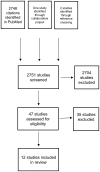The age-specific cumulative incidence of infection with pandemic influenza H1N1 2009 was similar in various countries prior to vaccination
- PMID: 21850217
- PMCID: PMC3151238
- DOI: 10.1371/journal.pone.0021828
The age-specific cumulative incidence of infection with pandemic influenza H1N1 2009 was similar in various countries prior to vaccination
Abstract
Background: During the influenza pandemic of 2009 estimates of symptomatic and asymptomatic infection were needed to guide vaccination policies and inform other control measures. Serological studies are the most reliable way to measure influenza infection independent of symptoms. We reviewed all published serological studies that estimated the cumulative incidence of infection with pandemic influenza H1N1 2009 prior to the initiation of population-based vaccination against the pandemic strain.
Methodology and principal findings: We searched for studies that estimated the cumulative incidence of pandemic influenza infection in the wider community. We excluded studies that did not include both pre- and post-pandemic serological sampling and studies that included response to vaccination. We identified 47 potentially eligible studies and included 12 of them in the review. Where there had been a significant first wave, the cumulative incidence of pandemic influenza infection was reported in the range 16%-28% in pre-school aged children, 34%-43% in school aged children and 12%-15% in young adults. Only 2%-3% of older adults were infected. The proportion of the entire population infected ranged from 11%-18%. We re-estimated the cumulative incidence to account for the small proportion of infections that may not have been detected by serology, and performed direct age-standardisation to the study population. For those countries where it could be calculated, this suggested a population cumulative incidence in the range 11%-21%.
Conclusions and significance: Around the world, the cumulative incidence of infection (which is higher than the cumulative incidence of clinical disease) was below that anticipated prior to the pandemic. Serological studies need to be routine in order to be sufficiently timely to provide support for decisions about vaccination.
Conflict of interest statement
Figures
References
-
- World Health Organization website, Chan M. World now at the start of an influenza pandemic. 2009. Available: http://wwwwhoint/mediacentre/news/statements/2009/h1n1_pandemic_phase6_2.... Accessed 17 December 2010.
-
- Hancock K, Veguilla V, Lu X, Zhong W, Butler EN, et al. Cross-reactive antibody responses to the 2009 pandemic H1N1 influenza virus. N Engl J Med. 2009;361:1945–1952. - PubMed
-
- Baker M, Kelly H, Wilson N. Euro Surveill 14: pii; 2009. Pandemic H1N1 influenza lessons from the southern hemisphere.19370 - PubMed
-
- Miller E, Hoschler K, Hardelid P, Stanford E, Andrews N, et al. Incidence of 2009 pandemic influenza A H1N1 infection in England: a cross-sectional serological study. Lancet. 2010;375:1100–1108. - PubMed
-
- Last JM. Oxford University Press; 2001. A Dictionary of Epidemiology, 4th Edition.196
Publication types
MeSH terms
LinkOut - more resources
Full Text Sources
Medical



